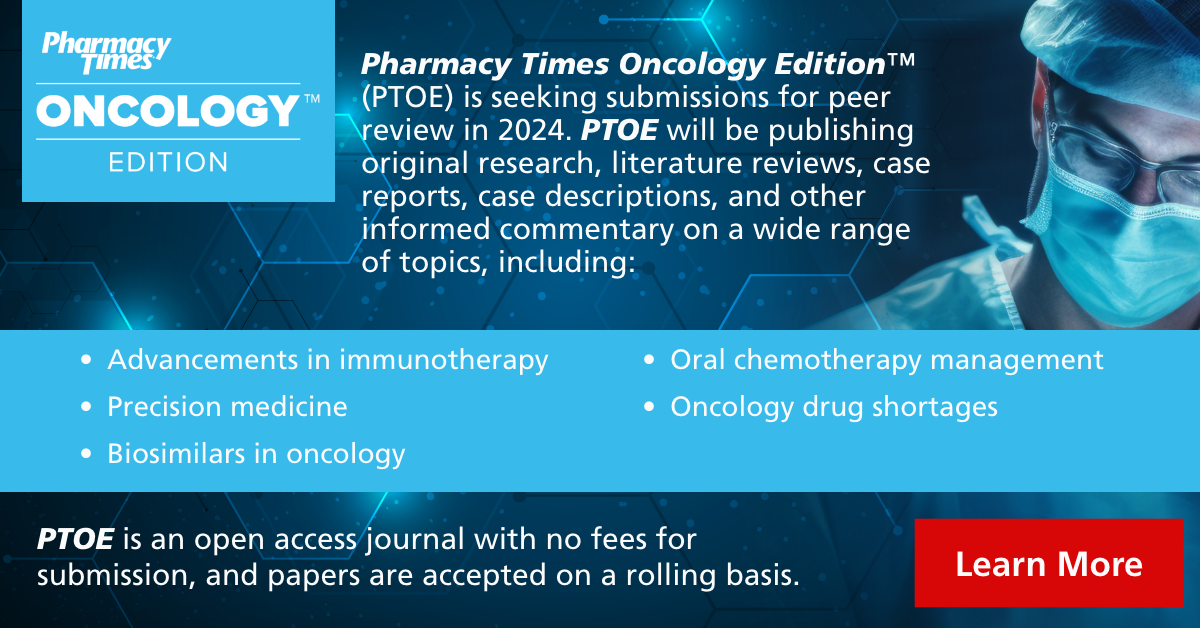Pharmacy Times interviewed Marlo Blazer, PharmD, BCOP, director of pharmacy at Columbus Oncology & Hematology, on the role of the oncology pharmacist on the patient care team. Blazer emphasizes the collaborative nature of the pharmacist's role within the oncology care team, noting the importance of knowledge, relationships, and effective communication in optimizing patient care. Additionally, Blazer highlights the importance of embracing constructive conflict and active engagement to thrive as an oncology pharmacist within the health care team.
Key Takeaways
- Role as a Resource: Oncology pharmacists act as a resource for patients, providers, and infusion nurses in a community oncology practice. They review treatments, counsel patients, and ensure treatment plans align with patient-centric factors like renal and hepatic function.
- Consistent Involvement: The level of involvement remains consistent on a day-to-day basis, involving close monitoring of regimens and patient-specific factors. Higher acuity regimens or patient histories often necessitate increased pharmacist engagement.
- Impact on Treatment Decisions: While not independently making treatment decisions, pharmacists provide recommendations to providers regarding dosing and treatment regimens. These recommendations are usually accepted by physicians due to the credibility and relationship developed over time.
- Involvement in EMR and Formulary Decisions: Pharmacists play a role in decisions around drugs included in the electronic medical record (EMR), ensuring alignment with evidence-based medicine, NCCN guidelines, and patient-specific needs. They present information about regimens, toxicity, cost, and efficacy, contributing to decision-making and striving for around 80% compliance in crowded treatment spaces.
- Optimizing Pharmacists' Role: Optimization of oncology pharmacists' roles within patient care teams depends on the pharmacist's inclination toward involvement in health care decision-making. When pharmacists possess comprehensive knowledge comparable to physicians and present data-driven cases, they effectively contribute to decisions and are well-received by physicians who value their input.
- Embracing Constructive Conflict: A vital aspect for the success of an oncology pharmacist is the willingness to engage in constructive conflict. Physicians value this engagement and are open to considering well-presented, data-driven recommendations from pharmacists, fostering better patient care outcomes.
Pharmacy Times: What is the focus of the work of an oncology pharmacist on the patient care team?
Marlo Blazer, PharmD, BCOP: The focus of the work of an oncology pharmacist on our care team—[Columbus Oncology & Hematology is] a community oncology private practice. We have 16 physician providers and 7 advanced practice providers [APPs] at our practice, and we have 7 oncology pharmacists at our practice.
So, on a day to day basis, our oncology pharmacists act as sort of a resource for the patients, the providers, and the infusion nurses as their patients are coming through our practice. We do offer in-house infusions, and we dispense oral oncolytics to the patients as well. So, our pharmacists review all the treatments on course 1 day 1, and we'll bring up to the provider any questions related to the regimen itself, like why this regimen is being used in this patient or in terms of dosing related to patient-centric factors like renal function, hepatic function. Then [oncology pharmacists] on the day of treatment will reiterate the counseling that the patient's already received, most of our patients do get a teaching visit with an APP, but I think it's well publicized that patients with cancer are particularly acute. They have a lot going on and reiteration of that education by another focus group, as in pharmacy, is very helpful. So, they'll counsel them on course 1 day 1 in treatment, or at dispensing of the oral oncolytic.
Pharmacy Times: How consistent is your level of involvement on the patient care team, and does that involvement level vary based on any specific factors?
Blazer: In terms of how we function on a day to day basis, it's pretty uniform. So, the question was how consistent is our level of involvement? It's consistent. We always check course 1 day 1 regimens and make sure that we're okay with what's going on with that patient. Then on the day of treatment, we [work] in conjunction with the infusion nursing professionals, we're looking at the labs and the toxicity assessment prior to sort of okaying that patient for treatment for the day and bringing up any questions or recommendations to the provider. That's every patient that comes through here—they get their eyes on them by a pharmacist. For treatment, any patient getting treatment will have pharmacy eyes on them.
In terms of specific factors where pharmacy gets more involved, there are some higher acuity regimens where certainly I think we get a little bit more involved in monitoring. There are also certain patient factors like previous history of reaction or something like that we do platinum desensitization here in house. And of course, we'll do all the work up for that and make sure that the rates and everything for the desensitization are there for the patient and for the nurse. We're more highly involved based on past patient experience, I think, would be the biggest variable to what ups the game, if you will, in terms of pharmacy involvement.
Pharmacy Times: What is the impact of an oncology pharmacist’s consultation on treatment and care decisions on the patient care team, and are pharmacists ever able to make treatment decisions independently?
Blazer: So much of that is sort of relational. We do not have a professional services agreement or anything like that with any of our providers to act under the medication management, I think is what it is, to act relatively independently. But we do get a lot of questions from the providers in terms of this is what's going on with the patient, [these are] the things that we see, could you take a look at this patient and come up with the dosing recommendations for how we're going to dose this regimen.
So, in that respect, it's a recommendation but to say that our recommendations get either accepted or rejected, I mean, they're accepted most of the time by our physicians. Again, a lot of it is relationship driven over time. We have, as oncology pharmacist, developed that credibility with the physicians that when they ask for our recommendations, what that really forays into is help me dose this patient appropriately.
Pharmacy Times: What is your involvement on decisions around certain drugs being included in the EMR?
Blazer: So, in terms of involvement and decisions around drugs being included in the EMR, I think that goes to how does a drug get on our formulary, if you will. The truth of the matter is all of our regimens here—and that's congruent with oncology in general—we practice evidence-based medicine, and the sort of compendia that holds our evidence at this point both from a payer standpoint and from a provider standpoint are the NCCN guidelines.
So, our [electronic health record (EHR)] updates with a sort of platform that's powered by NCCN. So, in other words, once the problem is placed appropriately in terms of the diagnosis, what can be prescribed is consistent with what NCCN recommends as a preferred listing of regimens that could be prescribed. So then when you have a crowded space, do we distill down from the NCCN pathways? We do, and that's usually by presentation from pharmacy about the crowded space, and we've got 3 different regimens that are providing the same efficacy, maybe slight differences in toxicity, here's the cost to the patient for these different regimens, do we do we have a winner for 80% of the patients that walk through here? And so, again, so much of what we do is relational with the physicians, and it's relationship driven, but they do trust what we say, and they do take our recommendations, but we've never asked them to be sort of 100% compliant with our recommendations either, because it's a very individualized treatment for each patient. Even the NCCN guidelines, if you plop a patient someplace on those guidelines, those guidelines will cover probably 85% of the patients you encounter, but they don't cover everybody. There's a reason that off-label use is sometimes used in oncology.
So, I think that our involvement is widely accepted in oncology, that the pharmacists are going to, in crowded spaces, say, “Is there a way that we could be consistent and standardize practice across the group?” If we can get 80% compliance, we've done a pretty good job.
Pharmacy Times:In your view, how might oncology pharmacists be better utilized on patient care teams?
Blazer: I think that part of that comes to comes down to the oncology pharmacist at hand. In my experience, I've worked in several different places and worked with a lot of different oncology pharmacists, and there are those that quite frankly want to be a part of the health care decision making [process] and those that that are less inclined to do so and are more inclined to be in more of a compliance role and dispensing role and those sorts of things.
So, I really think it depends on the oncology pharmacist and what they want out of involvement. I have found that if you are an oncology pharmacist and you read the same data that the physicians read, and you present to them with a case, maybe specific to crowded spaces, like we've got 3 different regimens, here are the differences and toxicities, here are the differences in efficacies, and here's the out of pocket cost to the patient. If you can go toe-to-toe with the physicians and present that data, they listen. I mean physicians are very, very reasonable people who want pharmacy involvement, who want the best for their patients, and who honestly don't mind a little bit of constructive conflict in getting there. But to thrive for an oncology pharmacist, you have to embrace that as well.








